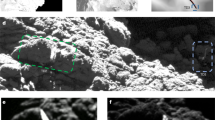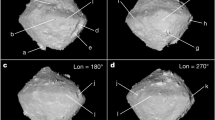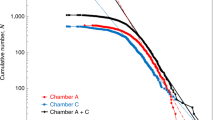Abstract
Although water vapour is the main species observed in the coma of comet 67P/Churyumov–Gerasimenko1,2 and water is the major constituent of cometary nuclei3,4, limited evidence for exposed water-ice regions on the surface of the nucleus has been found so far5,6. The absence of large regions of exposed water ice seems a common finding on the surfaces of many of the comets observed so far7,8,9. The nucleus of 67P/Churyumov–Gerasimenko appears to be fairly uniformly coated with dark, dehydrated, refractory and organic-rich material10. Here we report the identification at infrared wavelengths of water ice on two debris falls in the Imhotep region of the nucleus. The ice has been exposed on the walls of elevated structures and at the base of the walls. A quantitative derivation of the abundance of ice in these regions indicates the presence of millimetre-sized pure water-ice grains, considerably larger than in all previous observations6,7,8,9. Although micrometre-sized water-ice grains are the usual result of vapour recondensation in ice-free layers6, the occurrence of millimetre-sized grains of pure ice as observed in the Imhotep debris falls is best explained by grain growth by vapour diffusion in ice-rich layers, or by sintering. As a consequence of these processes, the nucleus can develop an extended and complex coating in which the outer dehydrated crust10 is superimposed on layers enriched in water ice. The stratigraphy observed on 67P/Churyumov–Gerasimenko11,12 is therefore the result of evolutionary processes affecting the uppermost metres of the nucleus and does not necessarily require a global layering to have occurred at the time of the comet’s formation.
This is a preview of subscription content, access via your institution
Access options
Subscribe to this journal
Receive 51 print issues and online access
$199.00 per year
only $3.90 per issue
Buy this article
- Purchase on Springer Link
- Instant access to full article PDF
Prices may be subject to local taxes which are calculated during checkout




Similar content being viewed by others
References
Hässig, M. et al. Time variability and heterogeneity in the coma of 67P/Churyumov–Gerasimenko. Science 347, http://dx.doi.org/10.1126/science.aaa0276 (2015)
Gulkis, S. et al. Subsurface properties and early activity of comet 67P/Churyumov–Gerasimenko. Science 347, http://dx.doi.org/10.1126/science.aaa0709 (2015)
Mumma, M. J. & Charnley, S. B. The chemical composition of comets—emerging taxonomies and natal heritage. Annu. Rev. Astron. Astrophys. 49, 471–524 (2011)
Ehrenfreund, P., Charnley, S. B. & Wooden, D. H. in Comets II (eds Festou, M. C., Keller, H. U. & Weaver, H. A. ) 115–133 (Univ. of Arizona Press, 2004)
Pommerol, A. et al. OSIRIS observations of meter-size exposures of H2O ice at the surface of 67P/Churyumov–Gerasimenko and interpretation using laboratory experiments. Astron. Astrophys. 583, A25 (2015)
De Sanctis, M. C. et al. The diurnal cycle of water ice on comet 67P/Churyumov–Gerasimenko. Nature 525, 500–503 (2015)
Capaccioni, F. et al. The organic-rich surface of comet 67P/Churyumov–Gerasimenko as seen by VIRTIS/Rosetta. Science 347, http://dx.doi.org/10.1126/science.aaa0628 (2015)
Sunshine, J. M. et al. Exposed water ice deposits on the surface of comet 9P/Tempel 1. Science 311, 1453–1455 (2006)
A’Hearn, M. F. et al. EPOXI at comet Hartley 2. Science 332, 1396–1400 (2011)
Sunshine, J. M. et al. The distribution of water ice on comet 103P/Hartley 2. Lunar Planet. Inst. Contrib. 1667, 6438 (2012)
Thomas, N. et al. The morphological diversity of comet 67P/Churyumov–Gerasimenko. Science 347, http://dx.doi.org/10.1126/science.aaa0440 (2015)
Massironi, M. et al. Two independent and primitive envelopes of the bilobate nucleus of comet 67P. Nature 526, 402–405 (2015)
Sierks, H. et al. On the nucleus structure and activity of comet 67P/Churyumov–Gerasimenko. Science 347, http://dx.doi.org/10.1126/science.aaa1044 (2015)
Auger, A. T. et al. Geomorphology of the Imhotep region on comet 67P/Churyumov–Gerasimenko from OSIRIS observations. Astron. Astrophys. 583, A35 (2015)
Coradini, A. et al. Virtis: an imaging spectrometer for the Rosetta mission. Space Sci. Rev. 128, 529–559 (2007)
Grundy, W. M. & Schmitt, B. The temperature-dependent near-infrared absorption spectrum of hexagonal H2O ice. J. Geophys. Res. 103, 25809–25822 (1998)
Mastrapa, R. M. et al. Optical constants of amorphous and crystalline H2O ice in the near infrared from 1.1 to 2.6 μm. Icarus 197, 307–320 (2008)
Sunshine, J. M. et al. The distribution of water ice in the interior of comet Tempel 1. Icarus 190, 284–294 (2007)
Prialnik, D., Benkhoff, J. & Podolack, M. in Comets II (eds Festou, M. C., Keller, H. U. & Weaver, H. A. ) 115–133 (Univ. Arizona Press, 2004)
Kossacki, K. J., Szutowicz, S. L. & Leliwa-Kopystyński, J. Comet 46P/Wirtanen: evolution of the subsurface layer. Icarus 142, 202–218 (1999)
Benkhoff, J., Seidensticker, K. J., Seiferlin, K. & Spohn, T. Energy analysis of porous water ice under space-simulated conditions: results from the KOSI-8 experiment. Planet. Space Sci. 43, 353–361 (1995)
Filacchione, G. Calibrazioni a terra e prestazioni in volo di spettrometri ad immagine nel visibile e nel vicino infrarosso per l’esplorazione planetaria. PhD dissertation, Univ. Studi di Napoli Federico II (2006); available at http://www.fedoa.unina.it/1462/1/Filacchione_Ingegneria_Aerospaziale_Navale_e_della_Qualita.pdf
Ammannito, E. et al. On-ground characterization of Rosetta/VIRTIS-M. I. Spectral and geometrical calibrations. Rev. Sci. Instrum. 77, 093109 (2006)
Filacchione, G. et al. On-ground characterization of Rosetta/VIRTIS-M. II. Spatial and radiometric calibrations. Rev. Sci. Instrum. 77, 103106 (2006)
Migliorini, A. et al. Comparative analysis of airglow emissions in terrestrial planets, observed with VIRTIS-M instruments on board Rosetta and Venus Express. Icarus 226, 1115–1127 (2013)
Raponi, A. Spectrophotometric analysis of cometary nuclei from in situ observations. PhD thesis, Univ. degli studi di Roma Tor Vergata (2014); preprint at http://arxiv.org/abs/1503.08172
Tosi, F. et al. Thermal measurements of dark and bright surface features on Vesta as derived from Dawn/VIR. Icarus 240, 36–57 (2014)
Tosi, F. et al. Thermal maps and properties of comet 67P as derived from Rosetta/VIRTIS data. Lunar Planet. Sci. Conf. XXXXVI, 2156 (LPI contribution no. 1832, 2015)
Fray, N. & Schmitt, B. Sublimation of ices of astrophysical interest: a bibliographic review. Planet. Space Sci. 57, 2053–2080 (2009)
Hapke, B. Theory of Reflectance and Emittance Spectroscopy (Cambridge Univ. Press, 2012)
Ciarniello, M. et al. Hapke modeling of Rhea surface properties through Cassini-VIMS spectra. Icarus 214, 541–555 (2011)
Ciarniello, M. et al. Photometric properties of comet 67P/Churyumov–Gerasimenko from VIRTIS-M onboard Rosetta. Astron. Astrophys. 583, A31 (2015)
Warren, S. G. Optical constants of ice from the ultraviolet to the microwave. Appl. Opt. 23, 1206 (1984)
Mastrapa, R. M. et al. Optical constants of amorphous and crystalline H2O-ice: 2.5-22 μm (4000-455 cm–1) optical constants of H2O-ice. Astrophys. J. 701, 1347–1356 (2009)
Clark, R. N. et al. The surface composition of Iapetus: mapping results from Cassini VIMS. Icarus 218, 831–860 (2012)
Acknowledgements
We thank the following institutions and agencies, which supported this work: Italian Space Agency (ASI, Italy), Centre National d’Etudes Spatiales (CNES, France), Deutsches Zentrum für Luft- und Raumfahrt (DLR, Germany), National Aeronautic and Space Administration (NASA, USA). VIRTIS was built by a consortium from Italy, France and Germany, under the scientific responsibility of the Istituto di Astrofisica e Planetologia Spaziali (IAPS) of INAF, Rome (Italy), which also led the scientific operations. The VIRTIS instrument development for the ESA has been funded and managed by ASI, with contributions from Observatoire de Meudon financed by CNES and from the DLR. The VIRTIS instrument industrial prime contractor was former Officine Galileo, now Selex ES (Finmeccanica Group) in Campi Bisenzio, Florence, Italy. We also thank the Rosetta Liaison Scientists, the Rosetta Science Ground Segment and the Rosetta Mission Operations Centre for their support in planning the VIRTIS observations. This research has made use of NASA’s Astrophysics Data System. This work is dedicated to Angioletta Coradini, conceiver of the VIRTIS instrument.
Author information
Authors and Affiliations
Contributions
G.F., M.C.D.S. and F.C. contributed to the data analysis and to the writing of the manuscript. G.F. and F.C. provided calibrated VIRTIS data. A.R. and M.C. provided the spectral fit. F.T. retrieved the temperatures. S.E., S.J., F.T. and C.L. provided geometry information. F.C., G.F., S.E., D.B.-M. and C.L. planned VIRTIS observations with R.N., M.C., A.C. and F.H. implementing telecommands sequences. R.P. and F.H. processed telemetry and data packets. All authors are instrument team members contributing to the discussion of the results.
Corresponding author
Ethics declarations
Competing interests
The authors declare no competing financial interests.
Additional information
The VIRTIS calibrated data will be available through the ESA’s Planetary Science Archive (PSA) website by early 2016 (http://www.rssd.esa.int).
Extended data figures and tables
Extended Data Figure 1 Water-ice grain size distribution derived from BAP1.
Grains are present in two monodispersed distributions with maxima at 56 μm and at 2 mm, corresponding to the intimate and areal mixing classes, respectively. The histogram is computed by selecting only pixels showing a water-ice abundance greater than 2% for the intimate mixing class and greater than 0.3% for areal mixing.
Rights and permissions
About this article
Cite this article
Filacchione, G., De Sanctis, M., Capaccioni, F. et al. Exposed water ice on the nucleus of comet 67P/Churyumov–Gerasimenko. Nature 529, 368–372 (2016). https://doi.org/10.1038/nature16190
Received:
Accepted:
Published:
Issue Date:
DOI: https://doi.org/10.1038/nature16190
This article is cited by
-
The Comet Interceptor Mission
Space Science Reviews (2024)
-
Dual storage and release of molecular oxygen in comet 67P/Churyumov–Gerasimenko
Nature Astronomy (2022)
-
Macro and micro structures of pebble-made cometary nuclei reconciled by seasonal evolution
Nature Astronomy (2022)
-
AMBITION – comet nucleus cryogenic sample return
Experimental Astronomy (2022)
-
An orbital water-ice cycle on comet 67P from colour changes
Nature (2020)
Comments
By submitting a comment you agree to abide by our Terms and Community Guidelines. If you find something abusive or that does not comply with our terms or guidelines please flag it as inappropriate.



